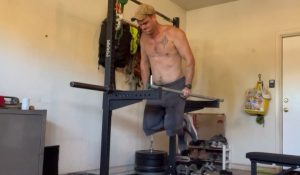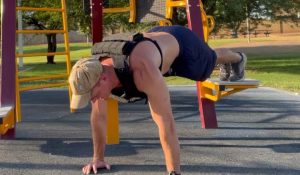Make no bones about it – we’re fans of push-ups here. But what about dips? In the world of basic bodyweight exercise routines, dips seem to get no love, despite the fact that their cousin, the pull-up, is viewed as a staple exercise!
If you’re trying to decide on dips vs push-ups for your own program, read on.
Push-ups vs dips: practical differences (and similarities)
I’m going to let you in on a little secret here: dips and push-ups are basically the same exercise.
Though they feature different pressing angles, they are both calisthenic horizontal pressing exercises. One involves keeping your feet on the ground, while the other involves suspending them in the air – that’s it.
There are many benefits of dips that don’t apply to the push-up as well. This is why they complement each other so well in the context of a program. For the sake of discussion, let’s explore some of the nuances between these two exercises:
For the sake of discussion, the practical differences between dips and push-ups are:
- Dips use a lower pressing angle, more similar to a decline bench press, whereas push-ups utilize a more horizontal angle, similar to a flat bench press.
- Dips require equipment, push-ups don’t.
- By their nature, dips are harder than push-ups, because you are lifting your entire body weight.
- Dips utilize a longer range of motion.
- Some people’s shoulders tolerate dips very well, and others’ don’t.
The similarities are:
- They are both compound horizontal pressing exercises.
- Muscles worked are identical: chest, anterior deltoid (front of the shoulder), and triceps.
At the end of the day, if we’re following evidence-based principles of building strength and muscle mass (doing 10-20 sets per week, close to failure, at a 2-4x per week frequency), it’s unlikely that our choice to do dips over push-ups (or vice versa) is going to be a big difference maker in our programming.
So how do you know which exercise to choose? Let’s examine the advantages of each, and then discuss their applications for various fitness goals:
Advantages of push-ups over dips

1. Portability
This may be the most obvious advantage: push-ups can be done anywhere. If you’re one of those wandering minimalists (no judgment here), then push-ups are likely going to be your go-to for a compound pressing exercise.
2. They can be easier on the joints
One of the benefits of (especially weighted) push-ups over dips certainly is that they can be easier on the joints. While I certainly don’t intend to nocebo anyone here, you just don’t hear as many complaints about shoulder pain from people who do push-ups instead of dips.
This is likely due to three factors:
- Push-ups just can’t be loaded as heavy as dips (ever heard of anyone doing a 5RM attempt on push-ups? Me neither …)
- Push-ups’ range of motion is self-limiting – your chest will hit the ground at some point
- Push-ups don’t place the shoulder in as extreme an end-range as dips, and therefore don’t require as much attention to be paid to finding a “proper” form that works for you
3. Push-ups can be loaded to work the clavicular head (upper chest)
If aesthetics are a concern for you, then you’ve no doubt waxed poetic about your desire to fill in your upper chest. While it’s basically impossible to truly “isolate” the clavicular head of the pectoralis major, it’s certainly possible to bias the stress of a push-up to work the upper chest muscles.
Incline bench press and “low to high” cable crossovers tend to reign supreme here. Turns out both of these exercises can be replicated somewhat with push-up variations:
- Decline push-ups (feet on a box, chair, or bench) replicate a low-incline press very well
- Diamond (or close grip) push-ups bias the stress to the upper chest as well
Though dips utilize the clavicular head more on the eccentric (lowering) phase of the lift, there simply isn’t a dip variation that truly stresses the upper chest very well.
4. Push-ups lend themselves well to “intensity” techniques
Because the mechanical tension (weight) on the muscle is relatively lower in push-ups, they tend to lend themselves better to intensity techniques like myo-reps, drop sets, rest-pause sets, and Tabata.
Advantages of dips over push-ups

1. Dips are a more accurate complement for pull-ups
While it’s often been said that pull-ups and push-ups are opposite sides of the same coin, that’s not really true.
It’s estimated that most people lift around 64% of their body weight in a push-up. In a dip, we’re lifting all of our body weight (or close to it). This more closely replicates the amount of weight we are moving in a pull-up.
If you’re utilizing a program that includes “heavier” and “lighter” presses, then dips pair very well with pull-ups as part of supersets or circuits.
2. They can be loaded heavy
If you’re trying to replicate the stress you’d feel from a heavy bench press or traditional gym lift, then weighted dips are the obvious option. Although it is absolutely possible to make push-ups harder in various ways, dip belts allow for a virtually non-existent strength ceiling on this exercise.
Don’t have a dip belt? Try throwing chains over your shoulders, wearing a weight vest, or holding a dumbbell or weight plate between your ankles or thighs.
Push-ups do have a ceiling for how much weight can be loaded. Even with a partner, weighted push-ups eventually become more of a circus trick (balancing act) than a strength exercise.
If maximal strength is your game, then dips are the logical choice.
3. They are excellent for lower pec and triceps development
In his Inside the Muscles series, Bret Contreras details the advantages of dips for developing the lower chest and triceps.
Whether you’re after a triceps builder to compliment your bench press numbers, or you’re simply seeking an aesthetic boost to these areas, dips are an excellent option.
Are dips bad for the shoulders?
Before we continue, we need to address the elephant in the room:
Dips, themselves, aren’t “bad” for the shoulders in the same way that deadlifts aren’t “bad” for the lower back and squats aren’t “bad” for the knees.
We need to apply some logic here:
Just like some lifters’ anthropometry seem to chronically disagree with low bar squats, for instance, there are some lifters whose anthropometry seems to disagree with dips.
Check out this bottom of the range of motion, and it’s not hard to see why jumping into the deep end with dips may not be the best idea for everyone:

I will note that I am one of those people. When I push hard on dips for weeks and weeks on end, I end up with cranky shoulders and sternum pain. However:
It can be tempting to blame the exercise here, but I don’t believe that’s fair – there are a number of likely culprits for this:
- Dips tend to be loaded heavier than push-ups
- They don’t naturally limit your range of motion the way push-ups do
- Dips place the shoulder in a more extreme position at the bottom of the range of motion
I believe these factors are likely more to blame than the exercise itself. To reference Contreras again, from his excellent article on “exercises to avoid”:
- “There are no contraindicated exercises, just contraindicated individuals. Learn how your body works and master its mechanics.”
Some people (myself included) have to use dips sparingly. Personally, I don’t do them more than once per week. You may find that this is the case for you, or that you can’t do them at all. This is fine – but that doesn’t mean dips are bad for everyone.
After all, many lifters (Arnold Schwarzenegger, Doug Hepburn, Jim Wendler, etc.) view dips as one of the essential exercises that exploded their numbers on other exercises.
I would much rather see someone experiment with this excellent exercise and find out for themselves. Start light, progress slowly, and see what happens. If you experience pain, back off, utilize an exercise that doesn’t cause pain, and slowly re-introduce them.
Push-ups vs dips for various fitness goals
Based on the above information, here are some quick guidelines on how to choose each exercise:
Choose push-ups if you:
- Are new to exercise
- Don’t have exercise equipment
- Want to work out wherever you go
- Would like to work on upper chest aesthetics
- Have tried dips in the past, but they hurt your shoulder
Choose dips if you:
- Are working on improving maximal strength
- Have access to parallel bars, dip bars, or other dip-specific equipment
- Want to drive up numbers on other lifts (like bench or overhead press)
- Would like to work on your lower chest aesthetics
Option C: Why not do both?
While “do both” is the boilerplate cop-out answer for questions such as this, I tend to look at these exercises more like “heavy” and “light” versions of the same movement. Such being the case, it’s not hard to come up with a few ways to incorporate both exercises into a routine:
Use dips and push-ups together as part of a bodyweight drop-set
- Exercise A1: Dips (within two reps of failure)
- Exercise A2: Push-ups with feet on a bench (within two reps of failure)
- Exercise A3: Pushups with hands on a bench (within two reps of failure)
Use dips on “heavy” days and push-ups on “light” days:
- Day 1: Dips – 3-4 sets close to failure
- Day 2: Push-ups – 3-4 sets close to failure
- Day 3: Repeat Day 1
- Day 4: Repeat Day 2
- Etc.
Use dips as a main movement and push-ups as a “finisher”
- Exercise A1: Dips – 3 sets close to failure, 2-3 minutes rest between sets
- Exercise A2: Pull Ups – 3 sets close to failure, 2-3 minutes rest between sets
- Exercise B1: Push-ups – myo reps or Tabata
- Exercise B2: Inverted rows – myo reps or Tabata
Final thoughts
If you’re looking to improve the strength or definition of your chest, shoulders, and triceps, it’s hard to go wrong with either exercise.
Try them both, master them both, and then pick the upper body exercise that fits your lifestyle and equipment availability better. You can always switch back and forth if you like, or utilize them both for different purposes in the context of a greater program.
Happy lifting!





















